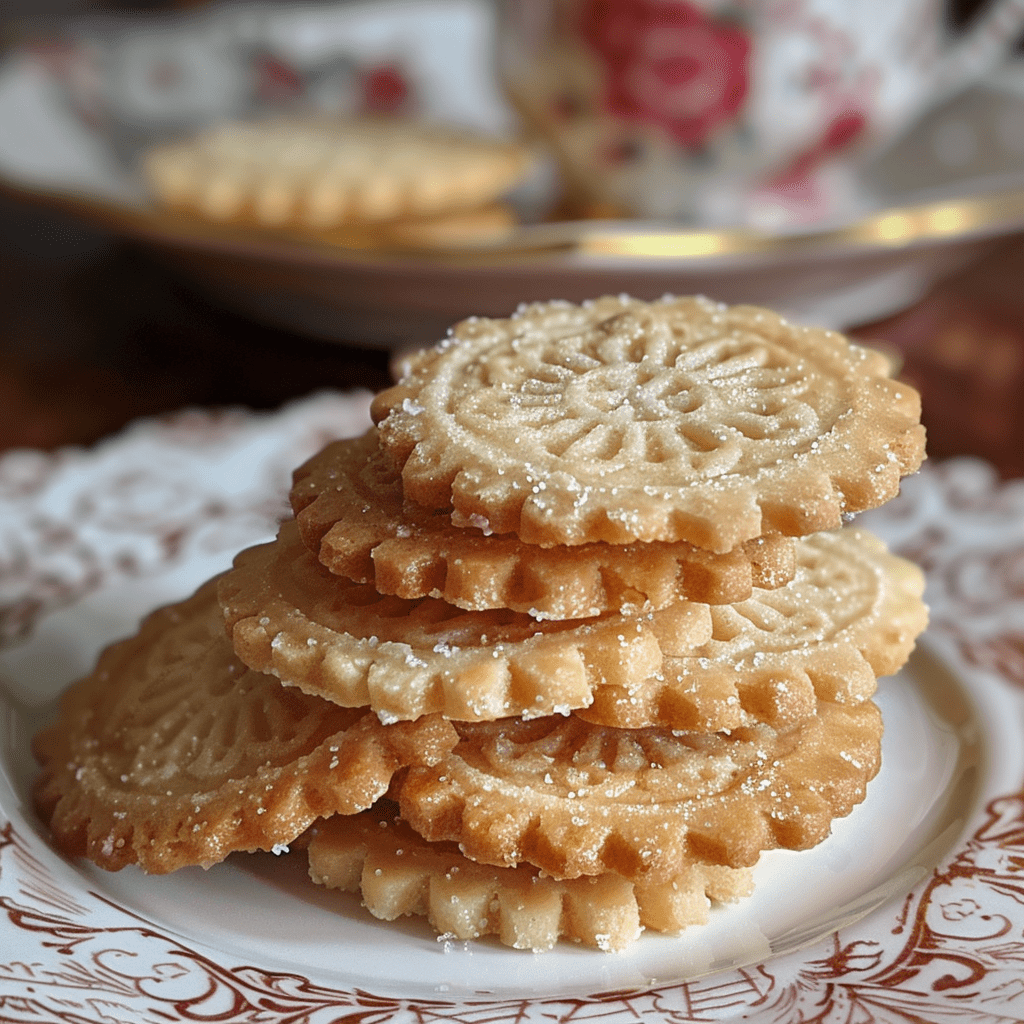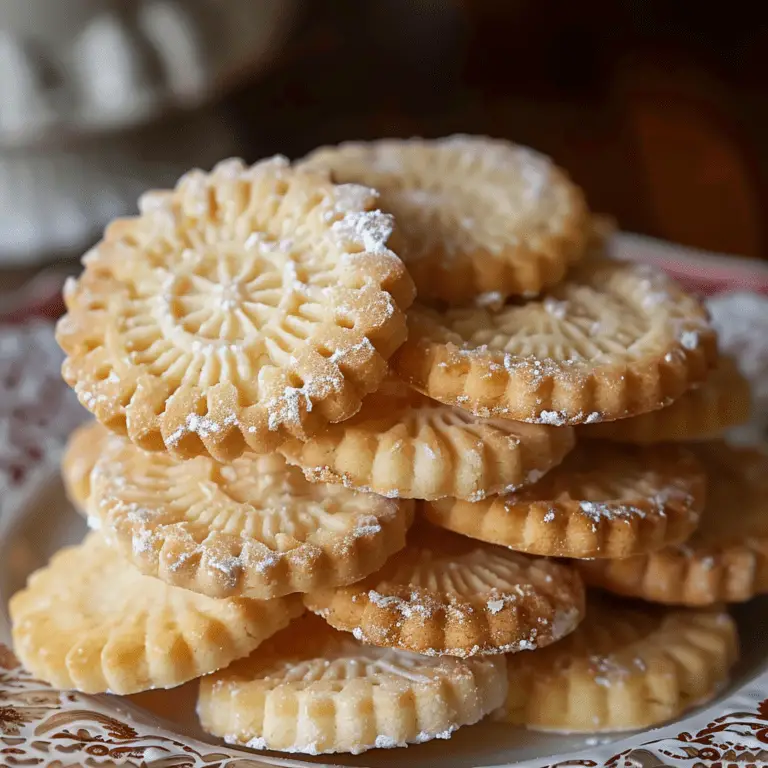French Butter Cookies, also known as Sablés Bretons, are a classic French treat known for their delicate, crumbly texture and rich, buttery flavor. Originating from the Brittany region of France, these cookies are a staple in French bakeries and homes. They are simple to make yet offer a sophisticated taste that pairs perfectly with tea or coffee. The secret to their irresistible flavor lies in high-quality butter and a touch of vanilla. This recipe guides you through the process of creating these delightful cookies, ensuring they are crisp on the outside and tender on the inside.
Ingredients
For the French Butter Cookies:
- ½ cup butter, softened to room temperature
- ½ cup powdered sugar, sifted
- 1 egg yolk, at room temperature
- ½ teaspoon vanilla extract
- 1 ⅛ cups all-purpose or cake flour
- ¼ cup granulated sugar, for coating
Instructions
Step 1: Make the Dough
Start by creaming together ½ cup of softened butter and ½ cup of sifted powdered sugar in a mixing bowl. Use an electric mixer on medium speed to blend the ingredients until the mixture turns pale and fluffy, which should take about 3-4 minutes. Add in 1 egg yolk and ½ teaspoon of vanilla extract, mixing until fully incorporated. Gradually sift in 1 ⅛ cups of all-purpose or cake flour, gently folding the flour into the mixture with a spatula until a soft dough forms.
Step 2: Chill the Dough
Wrap the dough in plastic wrap, flattening it slightly to create a disk. Refrigerate the dough for 20 minutes to firm it up, making it easier to handle and shape.
Step 3: Divide and Shape
After chilling, divide the dough into two equal halves. On a lightly floured surface, roll each portion into a log approximately 4 inches in length and 1 inch in diameter. The logs should be uniform in size to ensure even baking.
Step 4: Freeze for Readiness
Wrap each dough log in plastic wrap and place them in the freezer for 45 minutes. Freezing the dough helps it firm up, making it easier to slice into uniform rounds.
Step 5: Preheat and Prepare
Preheat your oven to 356°F (180°C) and line a baking sheet with parchment paper. Remove the dough logs from the freezer and unwrap them. Roll each log in ¼ cup of granulated sugar until they are evenly coated. This adds a delightful crunch to the exterior of the cookies. Using a sharp knife, slice each log into rounds about ⅜-inch thick. Arrange the slices on the prepared baking sheet, spacing them about 2 inches apart to allow for spreading.
Step 6: Bake to Golden Perfection
Bake the cookies in the preheated oven for 15-18 minutes, or until they turn a light golden brown around the edges. The exact baking time may vary depending on your oven, so keep a close eye on them to avoid overbaking. Once done, let the cookies cool on the baking sheet for 5 minutes before transferring them to a wire rack to cool completely.
Serving
Suggested Serving Options:
- With Tea or Coffee: These cookies are perfect with a cup of tea or coffee, enhancing your afternoon break.
- As a Gift: Pack them in a decorative tin or box to give as a thoughtful homemade gift.
- Dessert Platter: Include them in a selection of other cookies and pastries for a delightful dessert platter.
Serving Size:
This recipe yields approximately 18-20 cookies, depending on the thickness of the slices.
Nutritional Information:
- Calories: 101 kcal per cookie
- Prep Time: 20 minutes
- Cooking Time: 15-18 minutes
- Total Time: 1 hour 37 minutes
Storage:
Store the cookies in an airtight container at room temperature for up to one week. They can also be frozen for up to 3 months; thaw them at room temperature before serving.
Notes
Tips for Best Results:
- Quality Butter: Use high-quality butter for the best flavor. European-style butter, which has a higher fat content, can enhance the richness of the cookies.
- Chilling the Dough: Chilling the dough is crucial for maintaining the shape of the cookies and achieving the right texture.
- Even Slicing: Use a sharp knife to slice the dough logs evenly. This ensures uniform baking and prevents some cookies from being over or undercooked.
Variations:
- Flavored Butter Cookies: Add a hint of lemon or orange zest to the dough for a citrusy twist.
- Chocolate-Dipped: Once the cookies are baked and cooled, dip them halfway in melted chocolate and let them set on parchment paper for an added layer of indulgence.
- Spiced Cookies: Add a pinch of cinnamon or nutmeg to the dough for a warm, spiced flavor.

FAQs
Can I use unsalted butter instead of salted butter?
Yes, you can use unsalted butter. If you do, consider adding a pinch of salt to the dough to balance the sweetness and enhance the flavor.
What is the difference between all-purpose flour and cake flour?
All-purpose flour has a higher protein content than cake flour, which affects the texture of the cookies. Cake flour produces a more tender, delicate cookie. If using all-purpose flour, ensure you sift it well to incorporate air and achieve a lighter texture.
How can I prevent the dough from sticking while shaping it?
Lightly flour your work surface and hands to prevent the dough from sticking. If the dough becomes too sticky to handle, you can refrigerate it for a few more minutes to firm it up.
Why do I need to chill the dough before baking?
Chilling the dough helps to firm it up, making it easier to shape and slice. It also prevents the cookies from spreading too much during baking, ensuring they hold their shape.
Can I make the dough in advance?
Yes, you can prepare the dough in advance and refrigerate it for up to 2 days before baking. Alternatively, you can freeze the dough logs for up to 1 month. When ready to bake, let the logs thaw slightly at room temperature before slicing and baking.
What should I do if the dough is too crumbly?
If the dough is too crumbly and doesn’t come together, you can add a teaspoon of milk or water to help bind it. Mix gently until the dough holds together.
How do I know when the cookies are done?
The cookies are done when they turn light golden brown around the edges. They should still be slightly soft in the center when you take them out of the oven. They will firm up as they cool.
Can I add mix-ins to the dough?
Yes, you can add mix-ins like finely chopped nuts, dried fruits, or mini chocolate chips. Ensure they are finely chopped to avoid making the dough too chunky and difficult to slice.
What is the best way to package these cookies for gifting?
For gifting, place the cookies in a decorative tin or box lined with parchment paper. You can also wrap them in clear cellophane bags tied with a ribbon for a festive touch.
How can I ensure the cookies have a uniform shape?
Rolling the dough into even logs and using a sharp knife to slice the cookies will help ensure they are uniform in shape. Using a cookie cutter can also help if you prefer a more precise shape.
Conclusion
French Butter Cookies are a timeless treat that combines simplicity with elegance. Their buttery flavor and tender crumb make them a delightful addition to any occasion. Whether you’re enjoying them with a cup of tea, giving them as a gift, or adding them to a dessert platter, these cookies are sure to impress. The recipe is straightforward, and the results are always delicious. Enjoy baking these classic French treats and savor each bite of their rich, buttery goodness!

